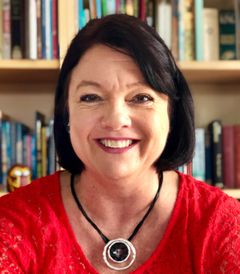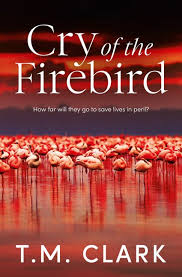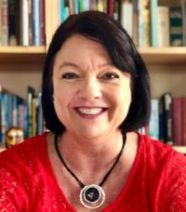
Welcome to Tea with Mrs B, an author interview series. Here to share a pot of tea and to chat about her brand new book, Cry of the Firebird, is T.M. Clark.

Born in Zimbabwe, T. M. Clark completed her primary school years at boarding school in Bulawayo. She attended senior school in South Africa, where she lived in the boarding school hostel as her home.
She began writing fiction in the UK while a stay-at-home mum to her two sons and she hasn’t looked back.
Now living on a small island near Brisbane in Queensland, Australia, T. M. Clark combines her passion for storytelling with her love for Africa.
Her first novel, My Brother-But-One, was shortlisted for the Queensland Literary Award 2014. She is also the author of novels Shooting Butterflies, Tears of the Cheetah and Nature of the Lion, as well as a novella, The Avoidable Orphan, and a children’s picture book, Slowly! Slowly!, a 2018 CBCA Notable Book, which are companion books to her novel Child of Africa.
Hello Tina. It is my pleasure to warmly welcome you to my blog, Mrs B’s Book Reviews. Thank you for joining me for Tea with Mrs B, an author interview series.
Thank you so much Mrs B for having me back to tea!
To set the mood for our tea infused interview, what is your preferred beverage, tea, coffee or other?
Milo please… I don’t drink tea or coffee
And side accompaniment, scone, cake or other?
I’ve a soft spot for real butter shortbread, so a few slices of that would be awesome, or anything chocolate…
Can you tell us what genres you write for and how many books you have had published?
I kind of struggle to say what genre I write in as I feel that they cross over so many of them. I suppose they could be classified as African-adventure-thriller-love story-saga. Cry of the Firebird is my sixth adult novel and I have one e-novella – which is a family Christmas story – and two published children’s books.
Cry of the Firebird is your latest release. Can you describe it in just a sentence?
A medical thriller set in Africa that deals with the corruption of the companies who put profit before the good of people, and the amazing people who fight against the them.
How long did it take you to write Cry of the Firebird?
First draft and edit before it went to the editor, about four months, but this book my editor pushed me even further, and I rewrote a huge amount again in another month or so. This was not the biggest structural/story edit I have had on a book. But it’s a better story for it and was worth the extra sweat and tears!
I passed a comment to her that I was getting worse, and she said no, her and my readers were just expecting better and richer from me, and I needed to keep digger deeper. I’m very grateful that she pushed me to go further.
I just love the striking flamingo design on the front cover of Cry of the Firebird. Are you able to tell us more about the significance of this image to the story?
I’m in love with this cover. A significant part of the story is tied to the rescue of a baby flamingo, and it’s released back into the wild. The story of the flamingo is also tied to the hero Piet’s journey.
Can you tell us about the research process to bring Cry of the Firebird to life?
After Amy Andrews suggested that I write a story with a flamingo to get a pink cover, I researched flamingo’s and where they were found in South Africa. I can’t say I remember ever seeing one in real life in the wild of South Africa, so lots of research was needed. I found one of four places in Africa that the lesser flamingo actually breeds, that has a manmade island in Kamfers Dam, Kimberley, South Africa which won environmental awards. When I found out about it I knew that this was the place to set my book. With its mismanagement of resource’s, and a people who believe in hope and that tomorrow will be better, I could join the Australian story that had been cooking inside my head for a while, with my African setting.
My big surprise in the book was Piet. He walked onto my page in his traditional loin cloth, arrows on his back and Nike takkies (trainers) on his feet. When I found Kimberley, I found the San People of Platfontein and this story couldn’t be told without me telling a little of theirs.
Where did the inspiration for your lead character of Lily come from?
Lily was part of my Australian story, and I have the Quirk family to thank for that. They told me of a story in their family, of a man who believed in ‘till death us do part’ and kept his word. He sold his treasured Stradivarius violin to buy a mobile home, and he took his Alzheimer’s suffering wife, away from the authorities and they lived out their days off grid. I wanted a better ending for them, I wanted to rewrite their story, and this is Lily and Quintin’s story, of love, endurance, support and not only their belief in each other, but also their friendship and coexistence.
People who read Nature of the lion, will have met Lily and Quintin briefly in the bush of Zimbabwe.
Can you tell us more about the setting locations featured in Cry of the Firebird?
The story centres around Kamfers Dam, in Kimberley, South Africa. Kimberley is mostly known for its diamonds and the ‘big hole’. There is a history rich with pioneer stories, of men who flocked there for riches, and those who were pulled from the hole, dead, or killed by others. But there is so much more there, than just diamonds. There’s a dam which is used as an effluent overflow, and over the years has become the place where flamingos can feed and breed. The dam is privately owned, but the effluent that gets pumped into it is controlled by the Sol Plaatje Municipality. There has been gross mismanagement of the site, and in some years, the water is allowed to raise too high, and cover the manmade island, and in years of drought, the water dries. Worse – the sewage treatment plant has not been maintained, and raw sewerage flows into the dam at the moment.
It’s an area that could be amazing, and be a tourist attraction like Lake Nakuru, Kenya, and yet there isn’t even a platform for viewing of the thousands of flamingos who nest there. This is a place where tourists scramble across train tracks to try to view the flamingos through long reeds and muddy ditches, only to scare the timid flamingo’s from their breeding grounds and cause them to abandon their turrets. It’s a place that is steeped in controversy. Fortunately, there are people there with hearts of pure gold that do what they can for the birds and the town.
In February this year there was a rescue initiated by private individuals, that saved approximately 3,000 babies, and a worldwide effort was undertaken. The babies were flown all over South Africa and so many people helped feed and love the chicks. Then when they were old enough most of those that had survived were returned to the dam. There is now a fight going on between the conservationist and one of these places that have held onto the young flamingo, and all we can do I hope that the good of the birds wins in the end, and they don’t land up like their counterpart baby elephants from Zimbabwe, in zoo’s around the world.
What are the main themes of your novel?
Hope. There is always hope. Hope that people will look out for others. That there are people who will rise to the challenges, and that there are people who believe in ‘till death us do part’.
Alzheimer’s and the effects that it has on a family were important themes in this novel, and the fact that families need to adjust.
It also explores the themes of corruption and collusion. It’s a terrible reality that no matter how good your quality systems are, they can be corrupted by individuals putting profit over people’s health, and that there are always officials that will turn the other way or worse… join in for the profits.
How different was the experience of writing Cry of the Firebird, compared to previous books?
Writing this story was a very different experience to my previous books. I actually dictated the first draft of this novel, which was a first for me. I had surgery and I couldn’t sit at my desk, so my couch became my office for a month. At first I felt quite stupid trying my sons different gaming headphones, and eventually found I got the best results by just getting Siri to transcribe by ramblings on my iPhone. She was better at handling my accent that the other apps I tried.
When I eventually got back to my desk, I found I’d told my story, but there was a fair bit of editing to get the story into a state that I could send to my publishers. That said I did get some of the highest word counts I’ve ever achieved in a single day, perhaps because I can talk so much, and love doing so.
Something that made writing Firebird difficult was that while I was writing, my mum was diagnosed with Alzheimer’s, so every time I wrote a symptom, I would be imagining that I was having those same things happening. My hubby and sons were really understanding and amazing, but this book demanded a lot out of me emotionally. It took a while after writing it to refill the ‘creative well’ and get the emotional rollercoaster back under control.
What do you hope readers will take away from reading Cry of the Firebird?
The knowledge that some people are willing to lay their lives down for others, to go into situations that are ‘not great’. That there is hope and that things don’t need to be left as they are and we can make things better, but we may need to work hard to create change.
What is the best part of being a published author?
I love the feel and smell of my books, when I get my author copies I can’t help but stroke them.
I love author lunches with my friends.
I love teaching storytelling to others, and the craft behind the stories.
That moment when a reader come up to me and says how much they enjoyed something I’ve written obviously never gets old. One of the really special things is when they tell me it brings back all their memories of visiting a place I’ve written about (hopefully good experiences and not the hell I tend to put my characters through).
But I think what I love the most, is being in a position to work around my family.
What writers have inspired you along the way to publication?
My husband bought me tickets to a Robin Hobb lunch. I adore this authors books. When I saw this lady with grey hair ushered in I was – like what? Robin is a she! I loved that Robin was a fantasy writer and a female in such a male dominated community! When Harlequin changed me into T.M. Clark I didn’t mind the androgynous nature of the name, after all Robin was a powerhouse in her genre, and I could be one in mine too.
Aside from writing, do you have any interesting hobbies?
Hobbies… I’m not sure this counts as a hobby, but it started as a mum’s project. In 2010/11 I visited Zimbabwe and saw the lack of school resources. I came home and collected a heap of books, okay a garage full, for a container. But I couldn’t raise the $20k needed to get it to them. As things turned out a friend of mine, Kate Skeet, was in PNG at the time and asked me if I knew where she could get some books for her mobile library she had started at the sustainable palm oil estate her husband was working on. We got the first container over to them with the help of Sue Krone from FastAir in Brendale. That was about 7 years ago, and we stopped counting at 100 000 books. We now create libraries and supply school resources all over PNG. I’m lucky enough to visit there for book week and a teachers conference to teach creative writing each year.
As for hobbies, when not writing stories, or doing PNG collections all over SE Queensland, or organising the CYA Conference, then I’m either in my garden or on Morton Bay, watching the migrating whales!
What is next on the horizon for T.M. Clark? Do you have any writing projects you would like to share with us?
I’m already writing my next adult thriller; it has themes of private security contractors and wild game farming in it at the moment (but that could change…) I hope that you will love that story as much as I’m loving writing it. I also have a few children’s books on the cusp of submission, more picture books, but also a middle grade series I have been working on, so stay tuned for those too…
What 2019 book releases are you most excited to read?
Amy Andrews – The Trouble with Christmas. I’m a Christmas junkie and this over the top romcom appealed to me so much.
Alli Sinclair – The Cinema at Starlight Creek. I loved this small town cinema story with a big heart.
And I always look forward to the next Tony Park book.
If you could slip back in time, what era would you travel to and why?
Pioneering days, when ships had multiple huge canvas sails, and rugged men who knew the ocean, and navigated by the stars. When ox wagons wheels cut deep into the African soil after heavy rains, and wild game roamed in abundance across vast untamed tracts of land, corralled only by the seasons. I think I would probably battle with fitting into society then… but it would be worth it, to shake those chauvinistic males attitudes up a bit!
Finally, wrapping up our tea themed interview, who would you most like to share a pot of tea with?
Other than you … as an author I’d like to sit with Sir James Percy FitzPatrick (author of Jock of the bushveld) who was around in the pioneer days. I’d love to discuss with him a time where everything was less muddled than it is now, when Africa was still wild and it was a frontier of freedom, adventure and a place where a man or woman could find themselves.
On a more personal note, I’d like to sit my dad and my sister Beverley one last time, and have a chance for them to know my children through my eyes, let them know that I’m still living an adventure!
Thank you for taking the time to visit Mrs B’s Book Reviews for Tea with Mrs B Tina. Congratulations on the publication of Cry of the Firebird!
In the badlands of Africa, a resourceful doctor fights to save her patients’ lives.  Australian thriller writer T.M. Clark returns with a vivid, action-packed adventure in the tradition of Wilbur Smith.
Australian thriller writer T.M. Clark returns with a vivid, action-packed adventure in the tradition of Wilbur Smith.
South African-born Doctor Lily Winters, a consultant with the World Health Organization, has been in the thick of some of the worst humanitarian disasters across the globe. But when she’s posted back to South Africa following the suspicious death of an ex-colleague, she faces the biggest medical mystery she’s ever seen.
The resettled San community of Platfontein is exhibiting a higher-than-average HIV infection rate, and their people are dying. The cases Lily takes over are baffling and despite her best efforts the medicine doesn’t seem to be helping.
To save this unique community, Lily and a policeman from the Kalahari, Piet Kleinman, join forces to trace the origins of the epidemic and uncover the truth. Their search drags them into the dangerous world of a corrupt industry driven by profit while the authorities meant to protect their community turn a blind eye. In a race against time Lily and Piet will put not only their careers but their lives on the line…
Cry of the Firebird by T.M. Clark was published on 18th November 2019 by Mira – AU. Details on how to purchase the book can be found here.
 Connect with T.M. Clark here:
Connect with T.M. Clark here:
Lovely interview Amanda! That cover sure is gorgeous. I’ve only read one of Tina’s books, I’m looking forward to reading more soon.
LikeLiked by 1 person
Thanks so much, it was an honour to collaborate with Tina on this one, I’ve admired her work for some time now. I hope you can read a few more of Tina’s books, they are very immersive.
LikeLike